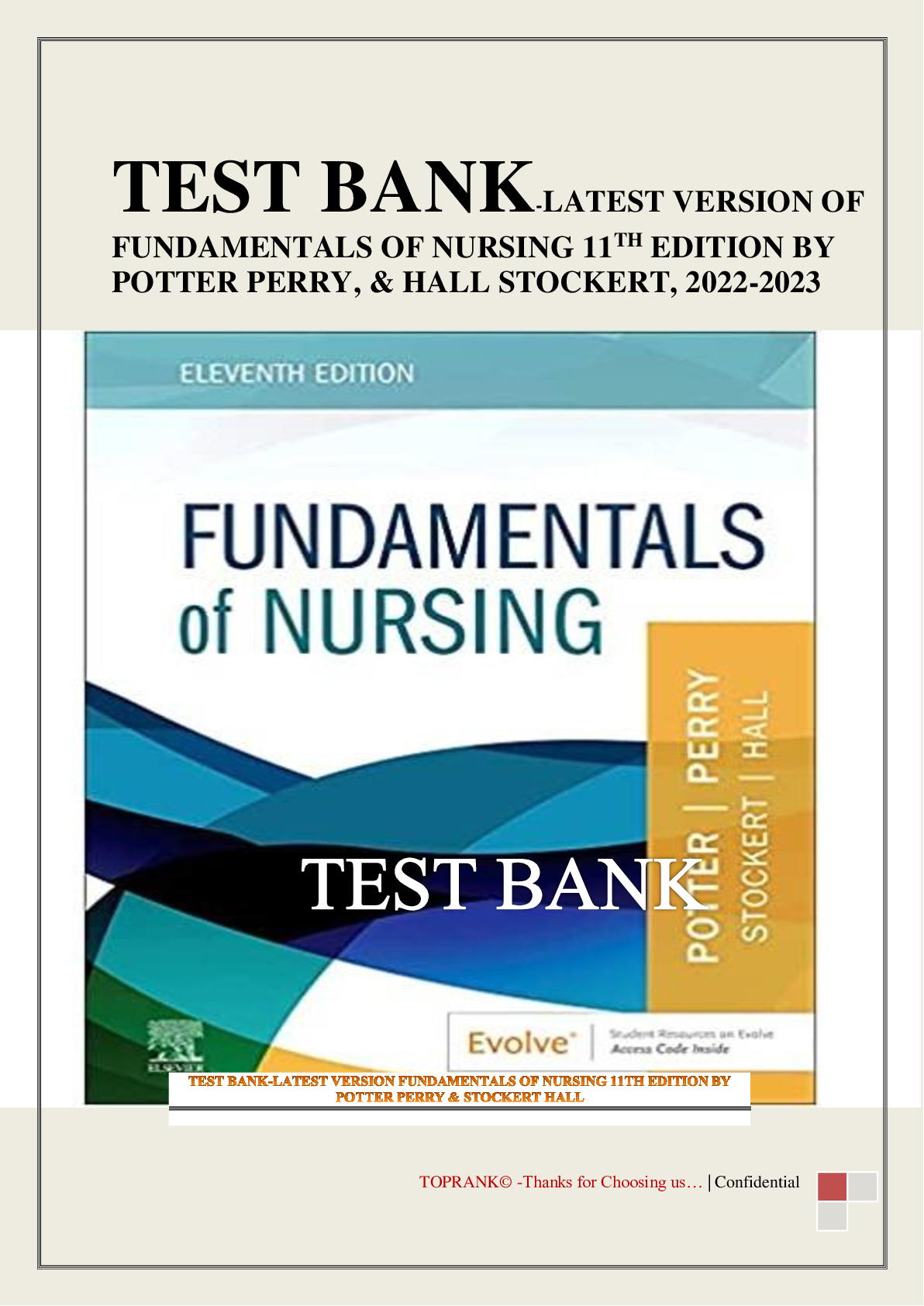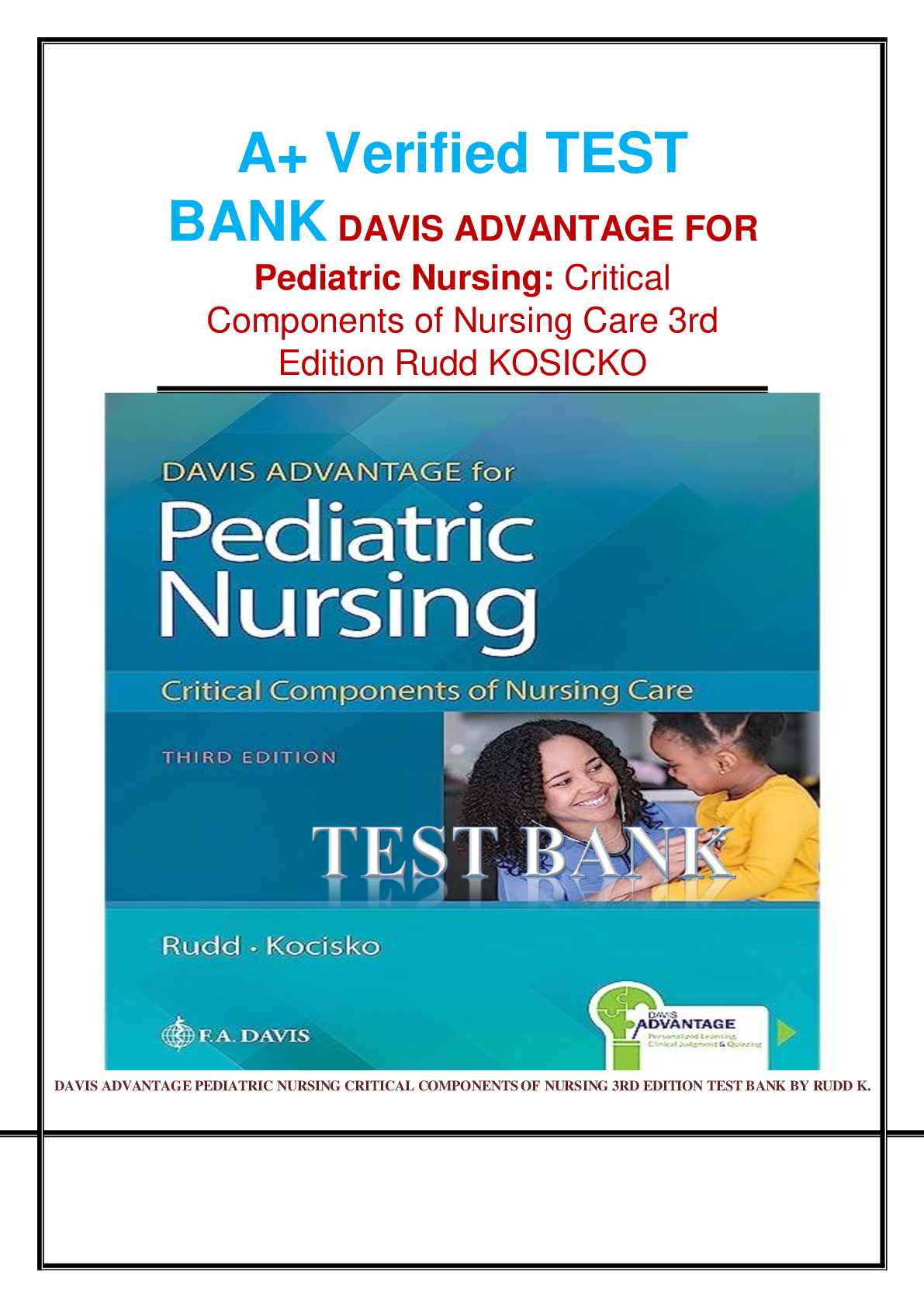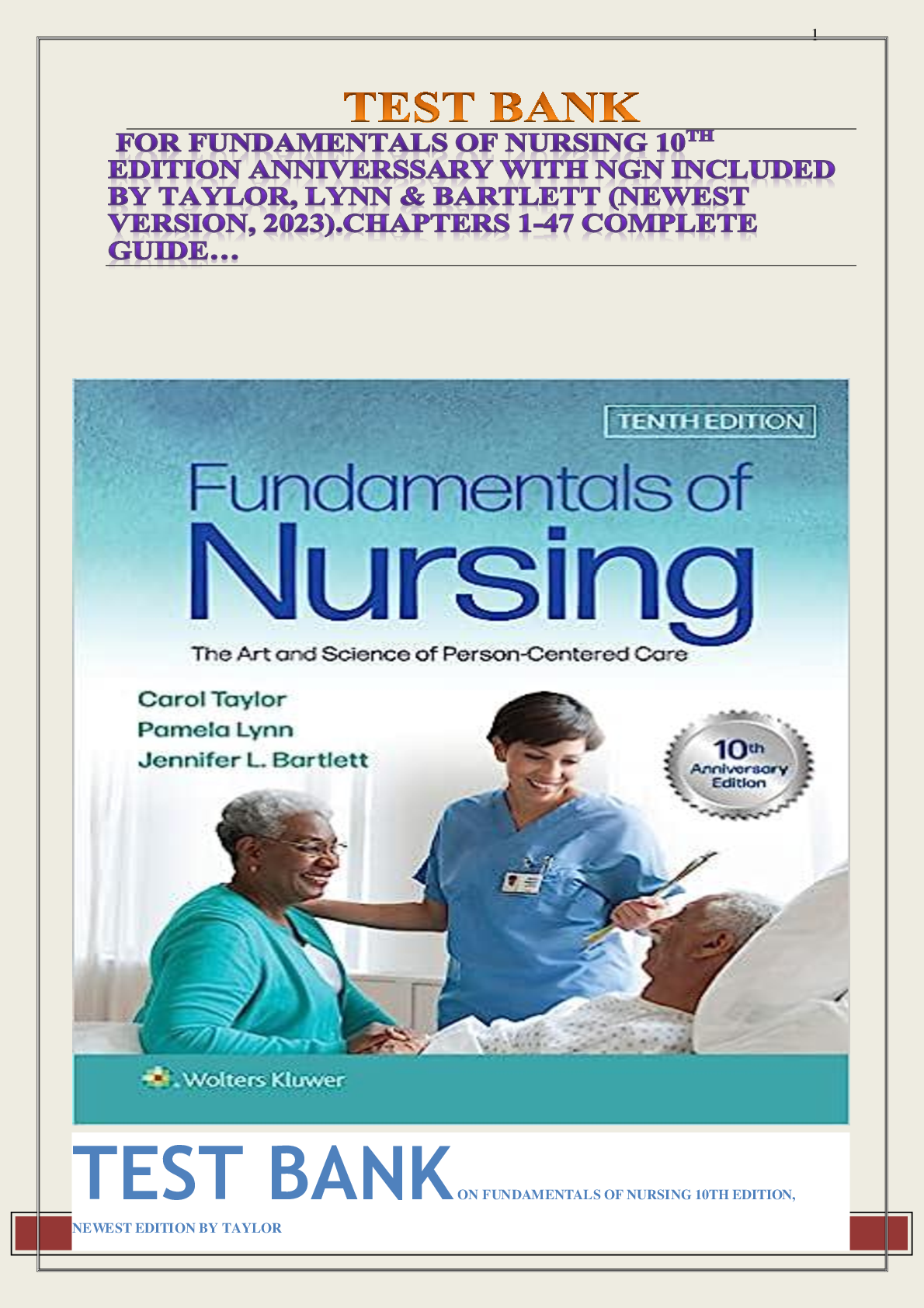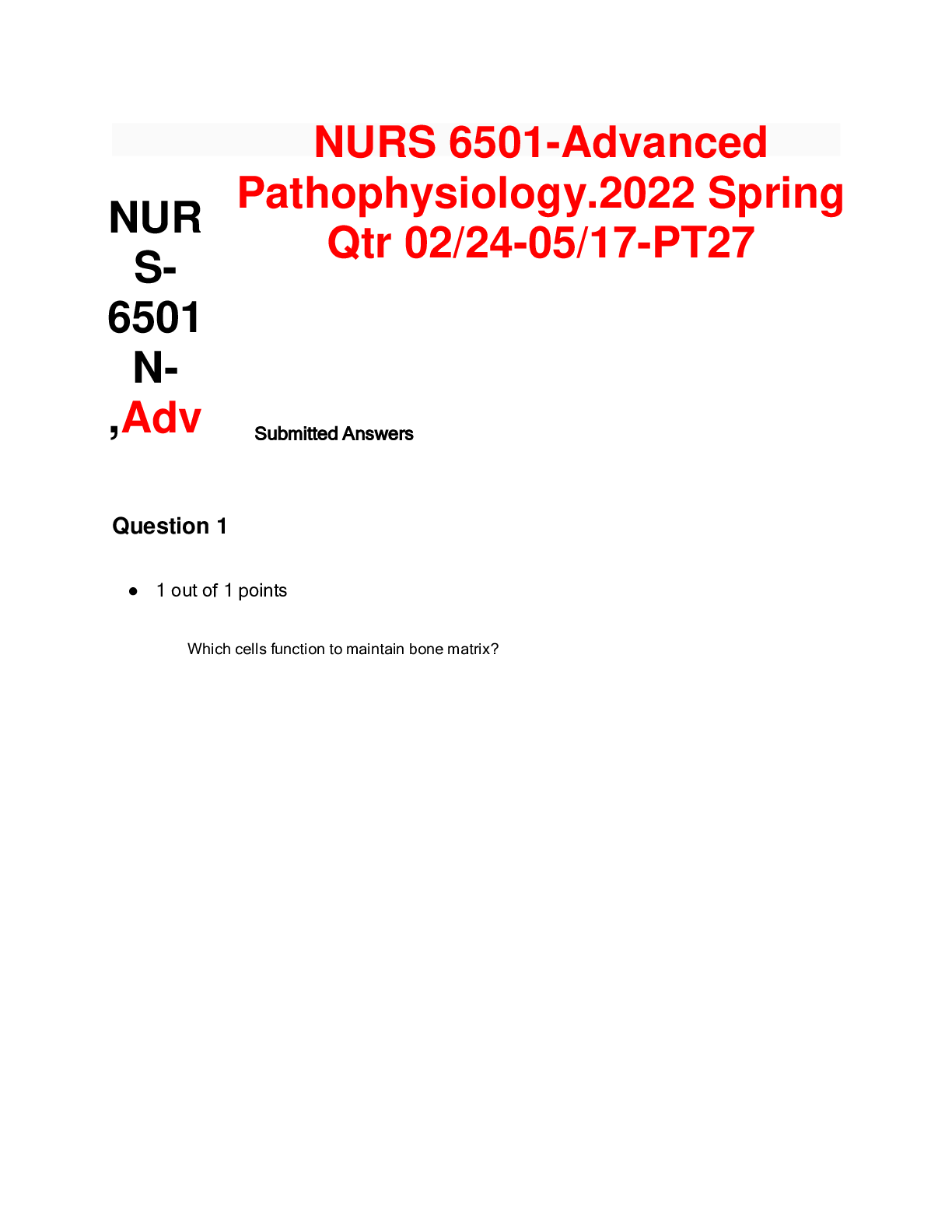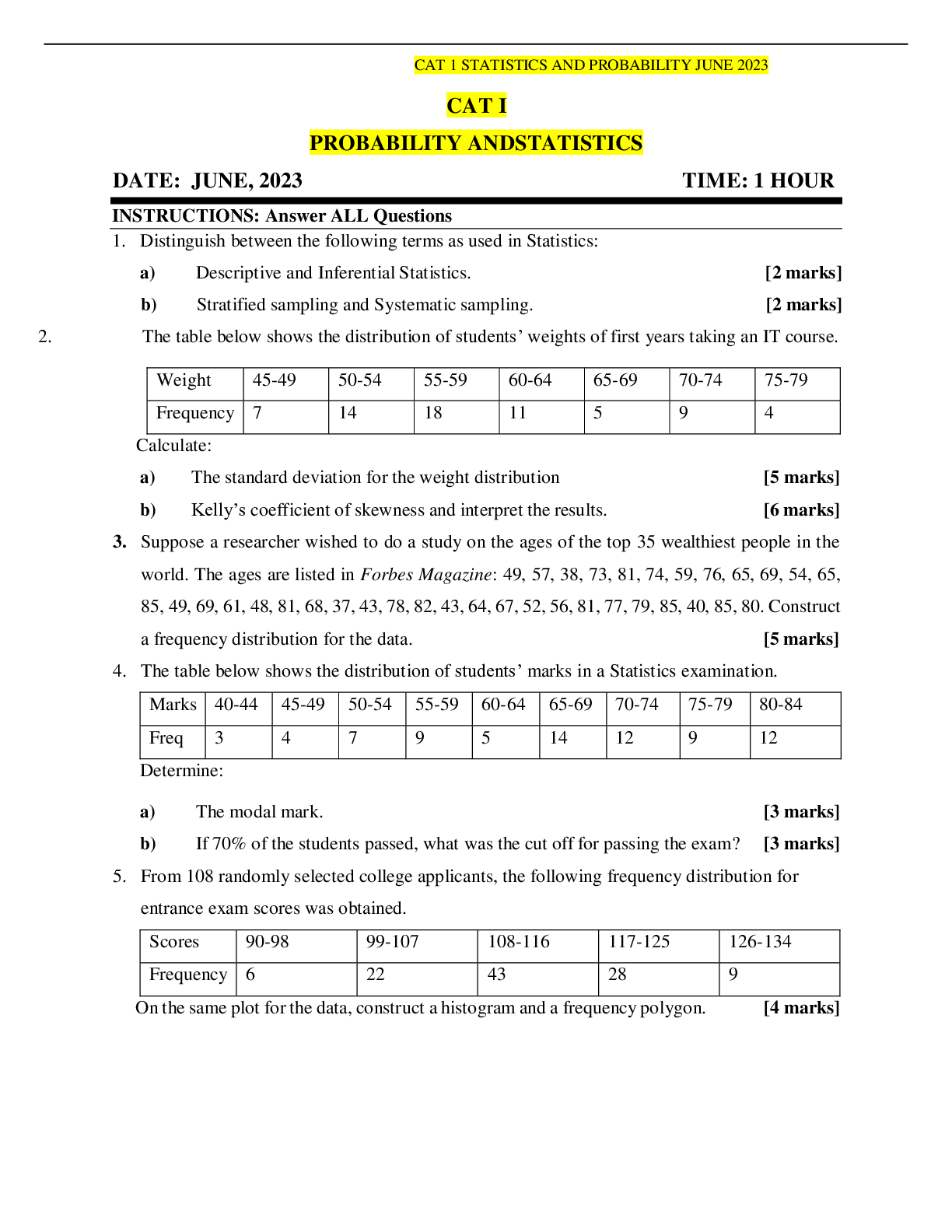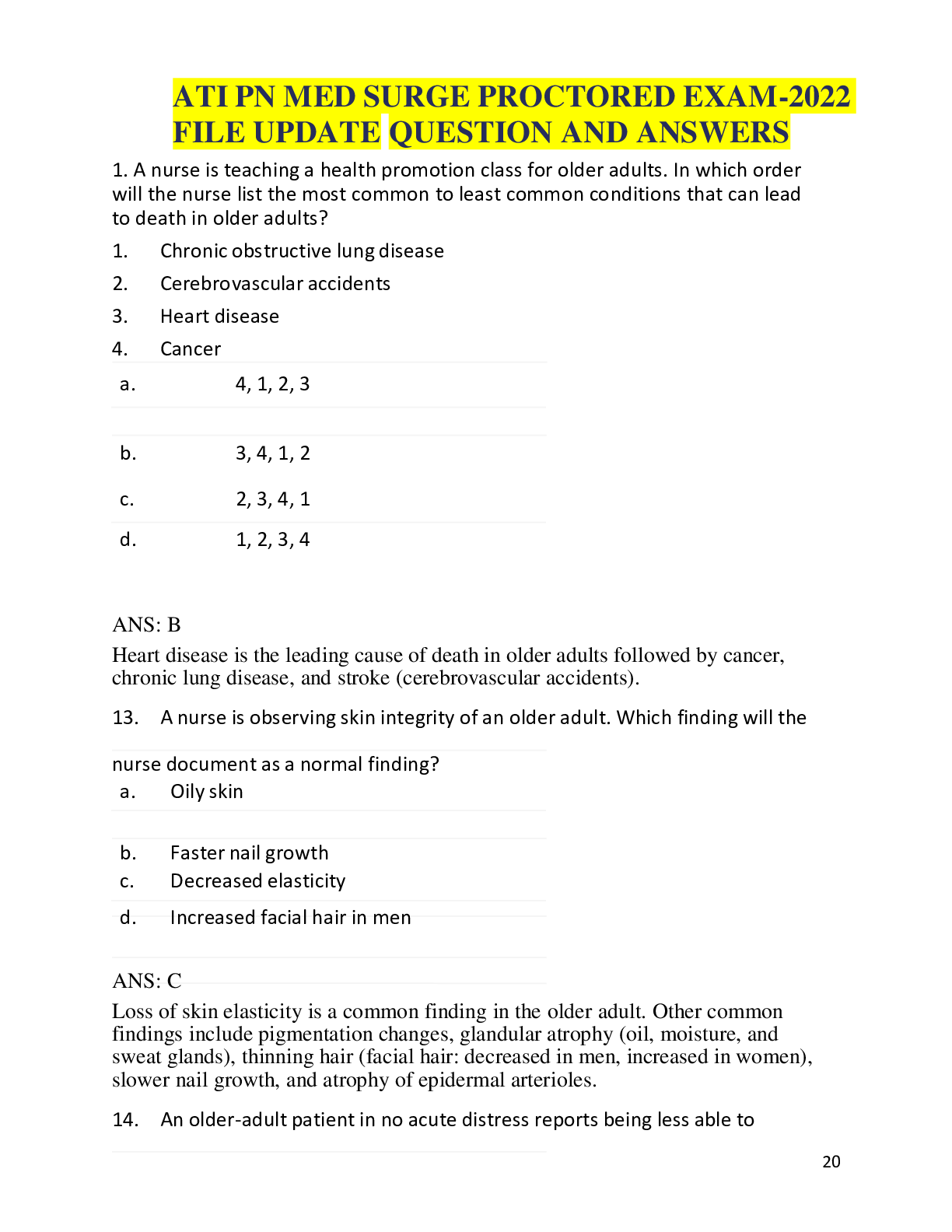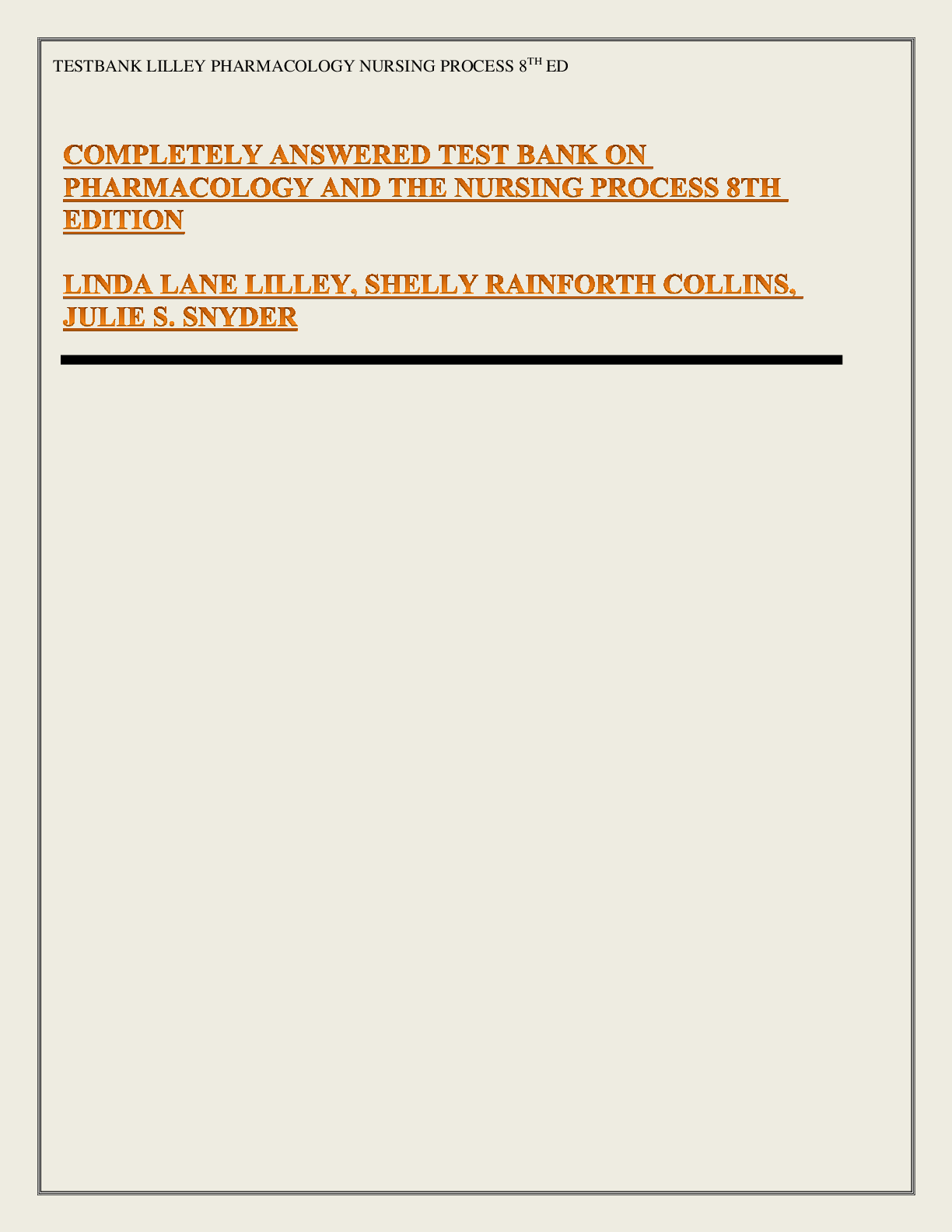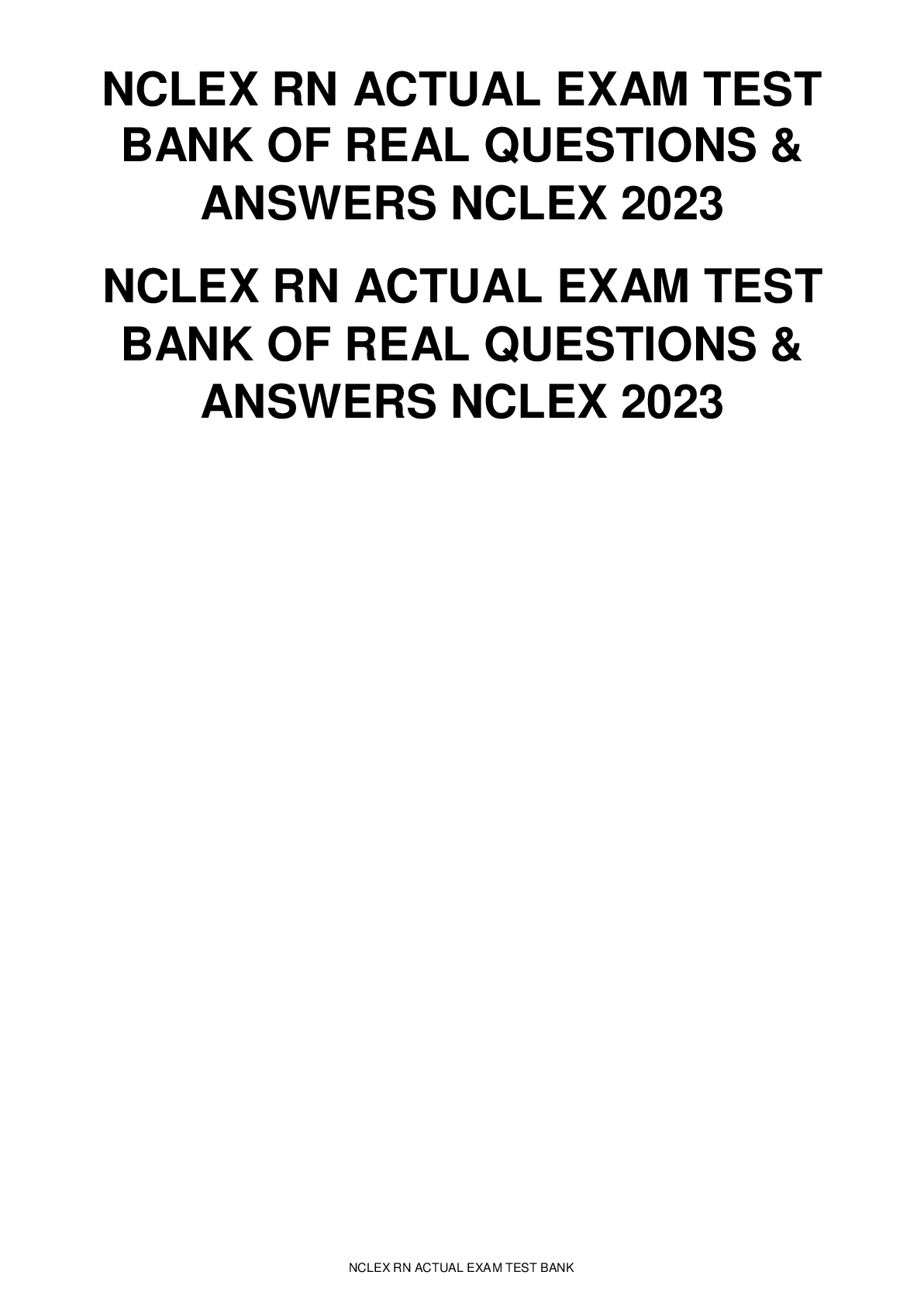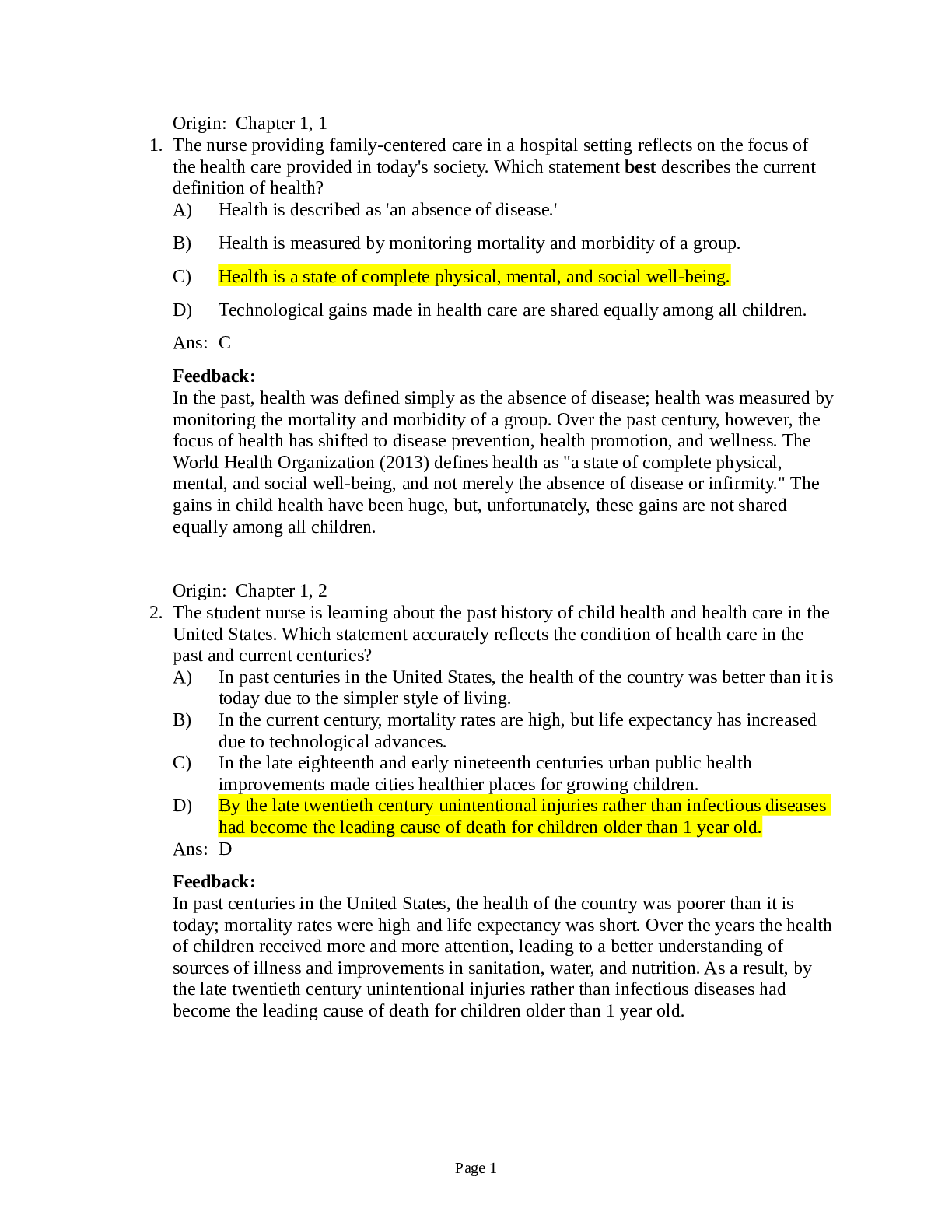NURSING PEDIATRICS > EXAM > Fully Answered Test Bank on Hockenberry- Wong's Essentials of Pediatric Nursing 10th Edition, 2022-0 (All)
Fully Answered Test Bank on Hockenberry- Wong's Essentials of Pediatric Nursing 10th Edition, 2022-023 File-Ace Your Exam with this 100/100 file
Document Content and Description Below
Chapter 01: Perspectives of Pediatric Nursing Hockenberry: Wong’s Essentials of Pediatric Nursing, 10th Edition 2022-2023, Questions and Answers Test Bank A++ Grade MULTIPLE CHOICE 1. A nurs... e is planning a teaching session for parents of preschool children. Which statement ex- plains why the nurse should include information about morbidity and mortality? a. Life span statistics are included in the data. b. It explains effectiveness of treatment. c. Cost-effective treatment is detailed for the general population. d. High-risk age groups for certain disorders or hazards are identified. ANS: D Analysis of morbidity and mortality data provides the parents with information about which groups of individuals are at risk for which health problems. Life span statistics is a part of the mortality data. Treatment modalities and cost are not included in morbidity and mortality data. DIF: Cognitive Level: Apply REF: p. 11 TOP: Integrated Process: Nursing Process: Planning MSC: Area of Client Needs: Health Promotion and Maintenance 2. A clinic nurse is planning a teaching session about childhood obesity prevention for parents of school-age children. The nurse should include which associated risk of obesity in the teaching plan? a. Type I diabetes b. Respiratory disease c. Celiac disease d. Type II diabetes ANS: D Childhood obesity has been associated with the rise of type II diabetes in children. Type I dia- betes is not associated with obesity and has a genetic component. Respiratory disease is not asso- ciated with obesity, and celiac disease is the inability to metabolize gluten in foods and is not as- sociated with obesity. DIF: Cognitive Level: Apply REF: p. 2 TOP: Integrated Process: Nursing Process: Planning MSC: Area of Client Needs: Health Promotion and Maintenance 3. Which is the leading cause of death in infants younger than 1 year? a. Congenital anomalies b. Sudden infant death syndrome c. Respiratory distress syndrome d. Bacterial sepsis of the newborn ANS: A Congenital anomalies account for 20.1% of deaths in infants younger than 1 year. Sudden infant death syndrome accounts for 8.2% of deaths in this age group. Respiratory distress syndrome ac- counts for 3.4% of deaths in this age group. Infections specific to the perinatal period account for 2.7% of deaths in this age group. DIF: Cognitive Level: Remember REF: p. 6 TOP: Integrated Process: Nursing Process: Assessment MSC: Area of Client Needs: Health Promotion and Maintenance 4. Which leading cause of death topic should the nurse emphasize to a group of African-American boys ranging in age from 15 to 19 years? a. Suicide b. Cancer c. Firearm homicide d. Occupational injuries ANS: C Firearm homicide is the second overall cause of death in this age group and the leading cause of death in African-American males. Suicide is the third-leading cause of death in this population. Cancer, although a major health problem, is the fourth-leading cause of death in this age group. Occupational injuries do not contribute to a significant death rate for this age group. DIF: Cognitive Level: Understand REF: p. 7 TOP: Integrated Process: Nursing Process: Planning MSC: Area of Client Needs: Health Promotion and Maintenance 5. Which is the major cause of death for children older than 1 year? a. Cancer b. Heart disease c. Unintentional injuries d. Congenital anomalies ANS: C Unintentional injuries (accidents) are the leading cause of death after age 1 year through adoles- cence. Congenital anomalies are the leading cause of death in those younger than 1 year. Cancer ranks either second or fourth, depending on the age group, and heart disease ranks fifth in the majority of the age groups. DIF: Cognitive Level: Remember REF: p. 7 TOP: Integrated Process: Nursing Process: Planning MSC: Area of Client Needs: Health Promotion and Maintenance 6. Which is the leading cause of death from unintentional injuries for females ranging in age from 1 to 14? a. Mechanical suffocation b. Drowning c. Motor vehicle–related fatalities d. Fire- and burn-related fatalities ANS: C Motor vehicle–related fatalities are the leading cause of death for females ranging in age from 1 to 14, either as passengers or as pedestrians. Mechanical suffocation is fourth or fifth, depending on the age. Drowning is the second- or third-leading cause of death, depending on the age. Fire- and burn-related fatalities are the second-leading cause of death. DIF: Cognitive Level: Remember REF: p. 3 TOP: Integrated Process: Nursing Process: Assessment MSC: Area of Client Needs: Health Promotion and Maintenance 7. Which factor most impacts the type of injury a child is susceptible to, according to the child’s age? a. Physical health of the child b. Developmental level of the child c. Educational level of the child d. Number of responsible adults in the home ANS: B The child’s developmental stage determines the type of injury that is likely to occur. The child’s physical health may facilitate the child’s recovery from an injury but does not impact the type of injury. Educational level is related to developmental level, but it is not as important as the child’s developmental level in determining the type of injury. The number of responsible adults in the home may affect the number of unintentional injuries, but the type of injury is related to the child’s developmental stage. DIF: Cognitive Level: Understand REF: p. 3 TOP: Integrated Process: Nursing Process: Planning MSC: Area of Client Needs: Health Promotion and Maintenance 8. Which is now referred to as the “new morbidity”? s ANS: D The new morbidity reflects the behavioral, social, and educational problems that interfere with the child’s social and academic development. It is currently estimated that the incidence of these issues is from 5% to 30%. Limitations in major activities of daily living and unintentional in- juries that result in chronic health problems are included in morbidity data. Discovery of new therapies would be reflected in changes in morbidity data over time. DIF: Cognitive Level: Remember REF: p. 2 TOP: Integrated Process: Nursing Process: Assessment MSC: Area of Client Needs: Health Promotion and Maintenance 9. A nurse on a pediatric unit is practicing family-centered care. Which is most descriptive of the care the nurse is delivering? n ANS: C The three key components of family-centered care are respect, collaboration, and support. Fam- ily-centered care recognizes the family as the constant in the child’s life. Taking over total care does not include the family in the process and may increase stress instead of reducing stress. The family should be enabled and empowered to work with the health care system. The family is ex- pected to be part of the decision-making process. DIF: Cognitive Level: Remember REF: p. 7 TOP: Integrated Process: Nursing Process: Implementation MSC: Area of Client Needs: Health Promotion and Maintenance 10. The nurse is preparing an in-service education to staff about atraumatic care for pediatric pa- tients. Which intervention should the nurse include? s t o ANS: B Preparing the child for any unfamiliar treatments, controlling pain, allowing privacy, providing play activities for expression of fear and aggression, providing choices, and respecting cultural differences are components of atraumatic care. In the provision of atraumatic care, the separation of child from parents during hospitalization is minimized. The nurse should promote a sense of control for the child. Preventing and minimizing bodily injury and pain are major components of atraumatic care. DIF: Cognitive Level: Understand REF: p. 8 TOP: Integrated Process: Nursing Process: Implementation MSC: Area of Client Needs: Psychosocial Integrity 11. Which is most suggestive that a nurse has a nontherapeutic relationship with a patient and fam- ily? [Show More]
Last updated: 11 months ago
Preview 1 out of 436 pages
Instant download
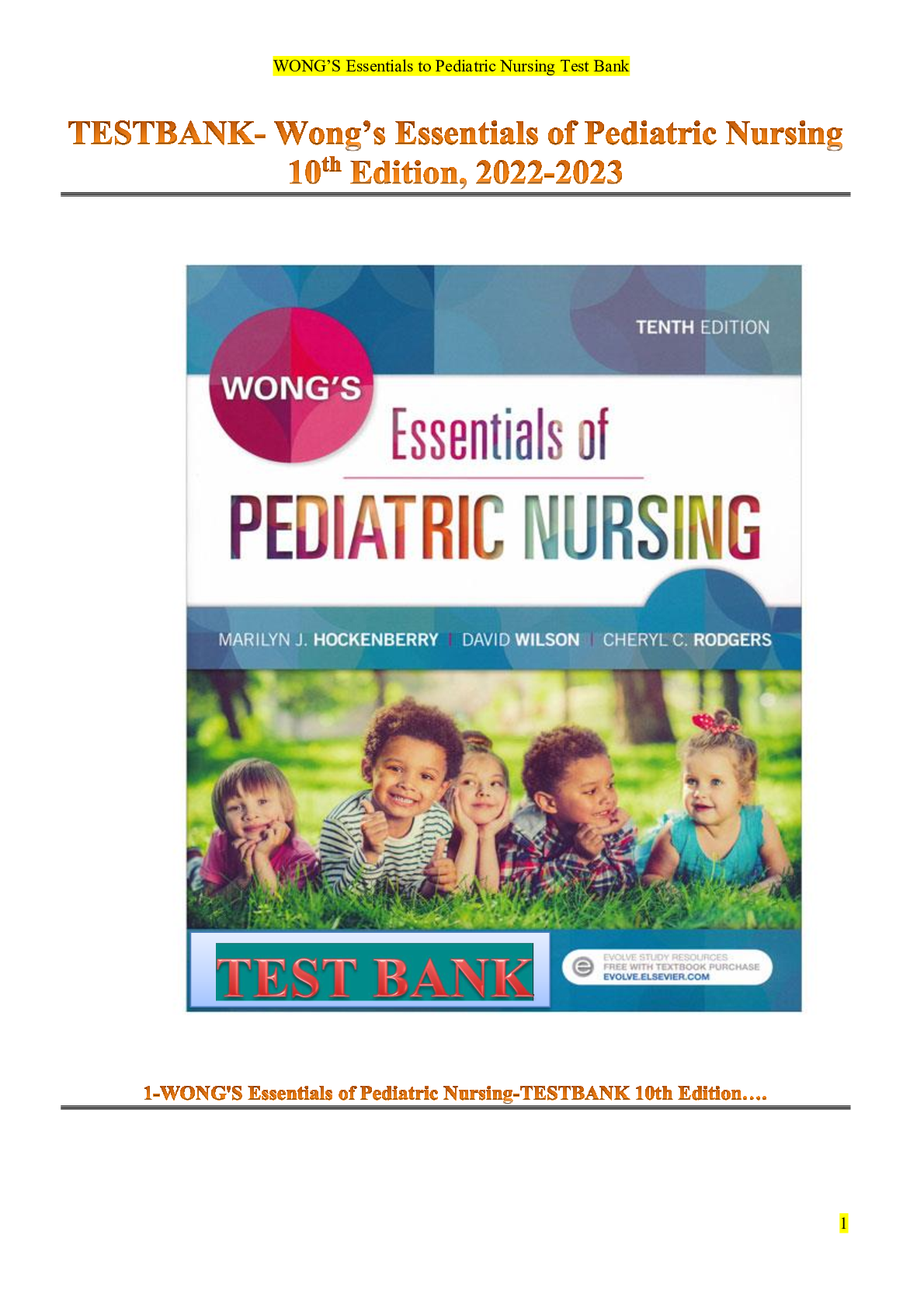
Buy this document to get the full access instantly
Instant Download Access after purchase
Add to cartInstant download
Reviews( 0 )
Document information
Connected school, study & course
About the document
Uploaded On
Jun 29, 2023
Number of pages
436
Written in
Additional information
This document has been written for:
Uploaded
Jun 29, 2023
Downloads
0
Views
38


